Mailing List Subscription
Written by Marcelo Schmitt
Written on , last modified onIntroduction
In this tutorial, we will learn how to subscribe to Linux related mailing lists such as git, dash, kernel janitors, and several kernel subsystems. Two approaches will be described: one using neomutt, other using Gmail web interface. We will also cover how to configure email filters so you don’t get your mailbox messed up after subscribing to the mailing lists.
VGER.KERNEL.ORG
VGER.KERNEL.ORG is a domain whose mission is to provide email list services to Linux kernel developers[1]. Mailing list subscription is only handled by email. By the time this tutorial was being written, no web interface was available for subscription.
Most of Linux kernel related mailing lists are listed in the vger-lists page. The subscription process in each of those lists is managed by a mailing list manager called Majordomo [2][3]. It only takes (correct) actions when triggered by emails in a very specific format. Emails sent to Majordomo must be in TEXT/PLAIN (must not contain any HTML tag), should have no multipart sections, nor anything “fancy”[4]. These rules apply to any email sent to Majordomo@vger.kernel.org, be it for subscription, unsubscription, or anything else.
Anyway, some helpful links can be found on the vger-lists page. Every mailing
list has a subscribe link which provides both vger majordomo’s email address
and a preformatted body to request subscription to the desired list. There is an
unsubscribe link with analogous properties too. We will use the information
provided by these links to request actions to Majordomo.

More information about vger’s Majordomo and the commands it accepts can be obtained sending a help email to it.
Subscribe with NeoMutt
NeoMutt is a command-line mail reader that easy the way patches (code contributions) are sent and received. In this particular case, NeoMutt will also easy the mailing list subscription process.
If NeoMutt is your default email reader, you might just click on the
subscribe link that NeoMutt will open a new email writing pane with To:
majordomo@vger.kernel.org set as the destination. As you press enter to confirm
it, the subject field will come empty (press enter again). If a confirmation
message appears warning that you are sending an email with no subject, press n
to tell NeoMutt you don’t want to cancel the message. You will see the email
body loaded from the subscribe link. Save the message within your editor (if
you’re using vim, type :w and press enter). Exit from your editor. You will
see a summary of the email you’re about to send. It will show the following
fields:
- From: <your email address>
- To: majordomo@vger.kernel.org
- CC:
- Bcc:
- Subject:
- Reply-To:
- Security: None
Review the email fields and press y to send it to Majordomo. If another
confirmation message appears, press n to don’t cancel the sending.
After some time Majordomo will send you an email with subject “Confirmation for subscribe <mailing list>”. Open the message to see the authentication code that lies inside. There will be a line that follows this format:
auth <code> subscribe <mailing list> <your email address>
Press r to answer Majordomo. Confirm Majordomo address. You may accept the
subject field or even erase it (Majordomo should not care about what the subject
field is). Type n to don’t cancel if you have cleared the subject. Type s or
just press enter to include Majordomo’s message in the answer. Erase everything
from the message body but the auth line. Also, erase the angular bracket and
space (> ) before the auth. Save the message, exit your editor, review the
fields, and type y to send your confirmation. If another confirmation message
appears, press n to tell NeoMutt you don’t want to cancel the dispatch.
If NeoMutt is not your default email reader, you can go through almost the same
subscription steps. The most significant difference is that you might have to
write the body for the subscription request email. This is the string you see
after body= when you hover the mouse above the subscribe link. This string
should be subscribe <list name>, where <list name> is the mailing list
name you can see after List: in the
vger-lists page. Note that the email
body should contain only the subscribe string.
That’s it. Within some time you shall receive a “Majordomo results” email
containing Succeeded and/or and welcoming email with the name of the mailing
list you requested subscription.
E-mail filters within Gmail
To better organize the mailbox and avoid being somewhat flooded by the Linux mailing lists (believe, a reasonable amount of emails may flow through a mailing list during a day), it is of use to have one (or more) filter. The filter job is to apply a label to mailing list emails and file them to a separate mailbox. This way you will be able to see all (and only) the emails related to a Linux subject within a defined box.
To do so, go to the settings page in the Gmail web interface.
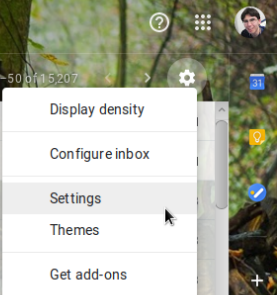
Click the “Filters and Blocked Addresses” tab and scroll down until you find a “create a new filter” link. Then, click on it.

In the filter configuration pane, type the email address of your Linux list in
the “To” field and your own email address between " in the “Doesn’t have”
field. This will select any email going to the Linux mailing list of interest,
except those that are related to you. In other words, email answering your
questions, RFCs, patches, that go to the list will not be filed, instead, they
will remain in your default inbox so you can see them immediately when accessing
your email.
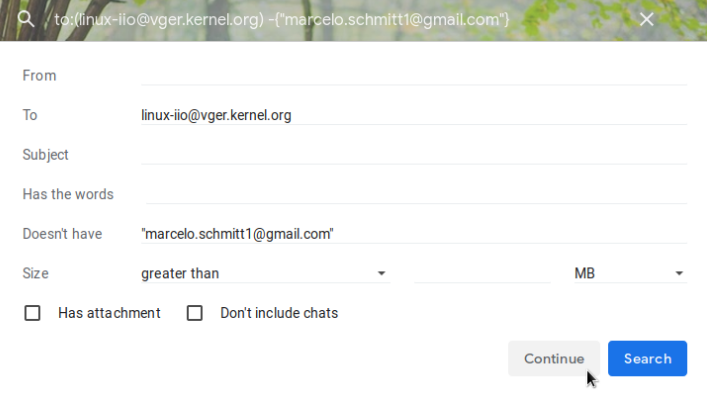
Click the “Create filter” button. Check “Skip the Inbox (Archive it)”, “Apply the label”, “Also apply filter to matching messages” and, if you feel like, “Never send it to Spam”. There’s a combo box beside the “Apply the label” to allow you to select which label to apply. It is your personal choice the name you want to give it. In this example, I used “Linux/iio” which is actually an “iio” label nested under a “Linux” label. Finally, click the “Create filter” button.
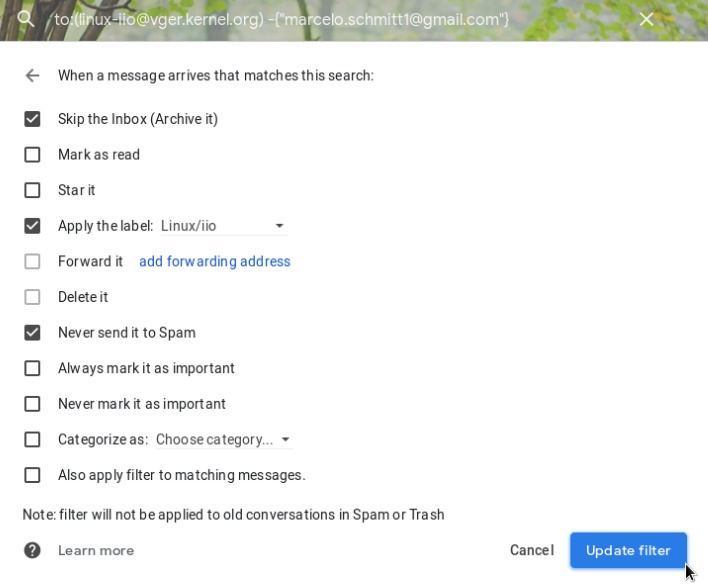
Some emails may be addressed to several mailing lists. For instance, a devicetree binding doc patch may go addressed to both iio and devicetree mailing lists. A security patch may go to crypto and janitors’ lists. In such cases, how can one know in which label an email will be accessible? The good news about that is: it will be available in both. The labels are cumulative therefore, in the above example, the email will be at both iio and devicetree boxes or, in both crypto and janitors boxes. Indeed, if an email goes to more than one of the mailing list you have subscribed, you will be able to see it in any of the label related to it (provided that you have properly set the filters).
This shall prevent the mailing lists from flooding your inbox as well as keeping things organized at your email account.
P.S.: Some of the prints are showing a “Continue” or “Update filter” button instead of “Create filter” as I already had the filter I was using as example.
Filters for FLUSP mailing lists (Bonus)
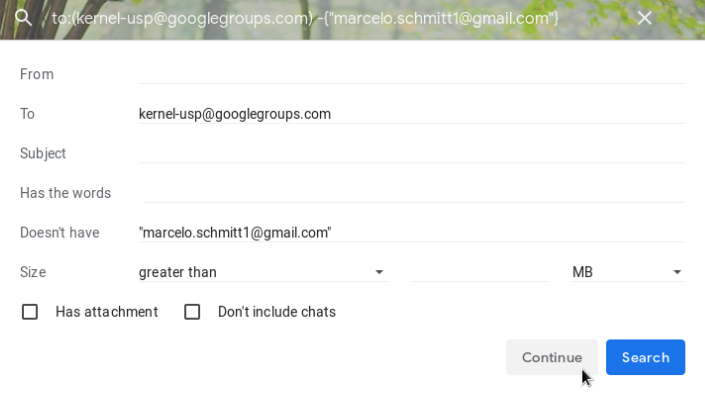
You don’t need to check the “Skip the Inbox” option since you probably want to see everything that is going on in the FLUSP contribuions list. =)
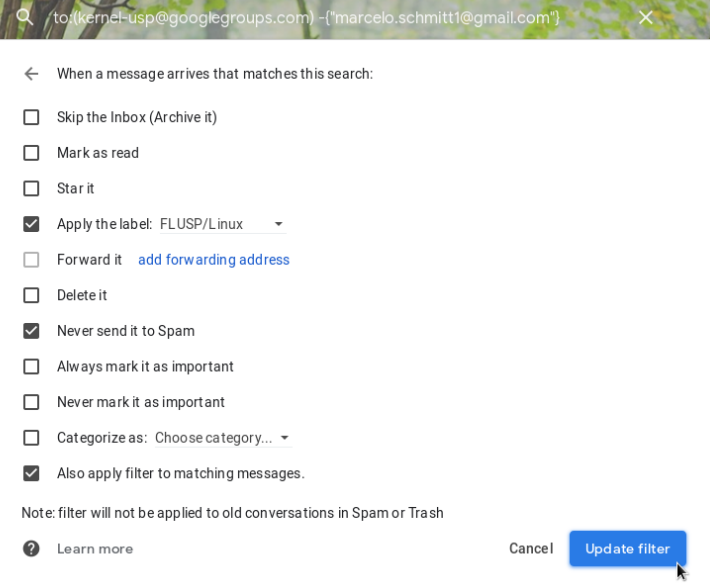
Unsubscribing
The unsubscribing process is analogous to the subscribe one. Clicking at one of
the unsubscribe links at vger-lists
will call your default email reader tool setting destination to
majordomo@vger.kernel.org and body to unsubscribe <mailing list>. Once you
send the email to unsubscribe the list, Majordomo will take care of
unsubscribing your address from it.
History
- V1: Release
References
[1] VGER.KERNEL.ORG. “VGER.KERNEL.ORG”. (2019) URL: http://vger.kernel.org/. ⤴
[2] Piers Cawley. “Majordomo”. (1995) URL: https://www.linuxjournal.com/article/1067. ⤴
[3] LinuxLinks. “Majordomo - mailing list manager”. (2019) URL: https://www.linuxlinks.com/majordomo/. ⤴
[4] VGER.KERNEL.ORG. “VGER.KERNEL.ORG Majordomo Info”. (2019) URL: http://vger.kernel.org/majordomo-info.html. ⤴
comments powered by Disqus
 FLUSP - FLOSS at USP
FLUSP - FLOSS at USP